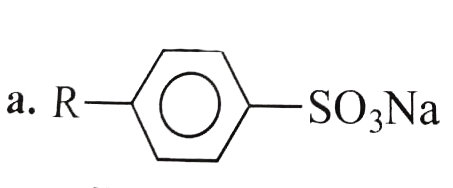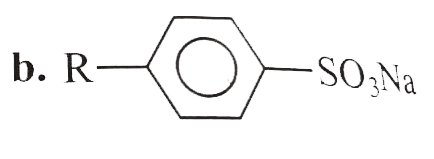Mnon-ionogenic surfactants are

C17H35COONa
CnH2n+1(OCH2CH2)xOH
All
The correct Answer is:C
Step by step video, text & image solution for Mnon-ionogenic surfactants are by Chemistry experts to help you in doubts & scoring excellent marks in Class 12 exams.
Updated on:21/07/2023Topper's Solved these Questions
- SURFACE CHEMISTRYBOOK - CENGAGE CHEMISTRYCHAPTER - SURFACE CHEMISTRYEXERCISE - Exercises Assertion-Reasoning
17 Videos
- SURFACE CHEMISTRYBOOK - CENGAGE CHEMISTRYCHAPTER - SURFACE CHEMISTRYEXERCISE - Exercises Interger
8 Videos
- SURFACE CHEMISTRYBOOK - CENGAGE CHEMISTRYCHAPTER - SURFACE CHEMISTRYEXERCISE - Exercises Multiple Correct
25 Videos
- SOLUTIONSBOOK - CENGAGE CHEMISTRYCHAPTER - SOLUTIONSEXERCISE - Ex 2.3 (Objective)
9 Videos
- SYNTHETIC AND NATURAL POLYMERSBOOK - CENGAGE CHEMISTRYCHAPTER - SYNTHETIC AND NATURAL POLYMERSEXERCISE - Exercises Assertion Reasoning
10 Videos
Similar Questions
What are surfactants ?
View SolutionIn macromolecular type of colloids, the dispersed particles are themselves large molecules (usually polymers). Since these molecules have dimensions comparable to those of colloidal particles, their dispersions are called macromolecular colloids. Most lyophilic sols belong to this category. These are certain colloids which behave as normal strong electrolytes at low concentrations, but exhibit colloidal properties at higher concentrations due to the formation of aggregated particles. These are known as micelles or associated colloids. Surface active agents like soaps and synthetic detergents belong to this class.
Critical micelle concentration (CMC) is the lowest concentration at which micelle formation appears. CMC increases with the total surfactant concentration. At concentration higher than CMC, they form extended parallel sheets known as lamellar micelles which resemble biological membranes. With two molecules thick, the individual molecule is perpendicular to the sheets such that hydrophilic groups are on the outside in aqueous solution and on the inside is a non-polar medium. In concentrated solution, micelles take the form of long cylinders packed in hexagonal arrays and are called lytotroic measomorphs.
In an aqueous solution (polar medium), the polar group points towards the periphery and the hydrophobic hydrocarbon chains point towards the conforming the core of the micelle.
Mecelles from the ionic surfactants can be formed only above a certain temperature called the Kraft temperature.
They are capable of forming ions Molecules of soaps and detergents consist of lyophilic as well as lyophilic parts which associate together to form micelles.
Micelles may contain as many as 100 molecules or more.
Surfactant molecules can cluster together as micelles, which are colloid sized cluster of molecules. Micelles form only above critical micelle concentration (CMC) and above certain temperature called kraft temperature. Which is false about micelle formation ?
View Solution
Knowledge Check
Anionic surfactants are
AC15H31COONaB CC18H37NH3ClDAll
CC18H37NH3ClDAllCationic surfactants are
AC17H35COONaB C
C DC16H33N(CH3)3Cl
DC16H33N(CH3)3ClAnionic surfactant (s) is (are) .
Athe substances whose anion possesses surfaces acitivityB CC18H37NH3ClDanion are associated to form miclles
CC18H37NH3ClDanion are associated to form miclles
In macromolecular type of colloids, the dispersed particles are themselves large molecules (usually polymers). Since these molecules have dimensions comparable to those of colloidal particles, their dispersions are called macromolecular colloids. Most lyophilic sols belong to this category. These are certain colloids which behave as normal strong electrolytes at low concentrations, but exhibit colloidal properties at higher concentrations due to the formation of aggregated particles. These are known as micelles or associated colloids. Surface active agents like soaps and synthetic detergents belong to this class.
Critical micelle concentration (CMC) is the lowest concentration at which micelle formation appears. CMC increases with the total surfactant concentration. At concentration higher than CMC, they form extended parallel sheets known as lamellar micelles which resemble biological membranes. With two molecules thick, the individual molecule is perpendicular to the sheets such that hydrophilic groups are on the outside in aqueous solution and on the inside is a non-polar medium. In concentrated solution, micelles take the form of long cylinders packed in hexagonal arrays and are called lytotroic measomorphs.
In an aqueous solution (polar medium), the polar group points towards the periphery and the hydrophobic hydrocarbon chains point towards the conforming the core of the micelle.
Mecelles from the ionic surfactants can be formed only above a certain temperature called the Kraft temperature.
They are capable of forming ions Molecules of soaps and detergents consist of lyophilic as well as lyophilic parts which associate together to form micelles.
Micelles may contain as many as 100 molecules or more.
Select incorrect statement(s) :
View SolutionIn macromolecular type of colloids, the dispersed particles are themselves large molecules (usually polymers). Since these molecules have dimensions comparable to those of colloidal particles, their dispersions are called macromolecular colloids. Most lyophilic sols belong to this category. These are certain colloids which behave as normal strong electrolytes at low concentrations, but exhibit colloidal properties at higher concentrations due to the formation of aggregated particles. These are known as micelles or associated colloids. Surface active agents like soaps and synthetic detergents belong to this class.
Critical micelle concentration (CMC) is the lowest concentration at which micelle formation appears. CMC increases with the total surfactant concentration. At concentration higher than CMC, they form extended parallel sheets known as lamellar micelles which resemble biological membranes. With two molecules thick, the individual molecule is perpendicular to the sheets such that hydrophilic groups are on the outside in aqueous solution and on the inside is a non-polar medium. In concentrated solution, micelles take the form of long cylinders packed in hexagonal arrays and are called lytotroic measomorphs.
In an aqueous solution (polar medium), the polar group points towards the periphery and the hydrophobic hydrocarbon chains point towards the conforming the core of the micelle.
Mecelles from the ionic surfactants can be formed only above a certain temperature called the Kraft temperature.
They are capable of forming ions Molecules of soaps and detergents consist of lyophilic as well as lyophilic parts which associate together to form micelles.
Micelles may contain as many as 100 molecules or more.
In multimolecular colloidal sols, atoms or molecules are held together by :
View SolutionIn macromolecular type of colloids, the dispersed particles are themselves large molecules (usually polymers). Since these molecules have dimensions comparable to those of colloidal particles, their dispersions are called macromolecular colloids. Most lyophilic sols belong to this category. These are certain colloids which behave as normal strong electrolytes at low concentrations, but exhibit colloidal properties at higher concentrations due to the formation of aggregated particles. These are known as micelles or associated colloids. Surface active agents like soaps and synthetic detergents belong to this class.
Critical micelle concentration (CMC) is the lowest concentration at which micelle formation appears. CMC increases with the total surfactant concentration. At concentration higher than CMC, they form extended parallel sheets known as lamellar micelles which resemble biological membranes. With two molecules thick, the individual molecule is perpendicular to the sheets such that hydrophilic groups are on the outside in aqueous solution and on the inside is a non-polar medium. In concentrated solution, micelles take the form of long cylinders packed in hexagonal arrays and are called lytotroic measomorphs.
In an aqueous solution (polar medium), the polar group points towards the periphery and the hydrophobic hydrocarbon chains point towards the conforming the core of the micelle.
Mecelles from the ionic surfactants can be formed only above a certain temperature called the Kraft temperature.
They are capable of forming ions Molecules of soaps and detergents consist of lyophilic as well as lyophilic parts which associate together to form micelles.
Micelles may contain as many as 100 molecules or more.
Cleansing action of soap occurs because :
View SolutionIn macromolecular type of colloids, the dispersed particles are themselves large molecules (usually polymers). Since these molecules have dimensions comparable to those of colloidal particles, their dispersions are called macromolecular colloids. Most lyophilic sols belong to this category. These are certain colloids which behave as normal strong electrolytes at low concentrations, but exhibit colloidal properties at higher concentrations due to the formation of aggregated particles. These are known as micelles or associated colloids. Surface active agents like soaps and synthetic detergents belong to this class.
Critical micelle concentration (CMC) is the lowest concentration at which micelle formation appears. CMC increases with the total surfactant concentration. At concentration higher than CMC, they form extended parallel sheets known as lamellar micelles which resemble biological membranes. With two molecules thick, the individual molecule is perpendicular to the sheets such that hydrophilic groups are on the outside in aqueous solution and on the inside is a non-polar medium. In concentrated solution, micelles take the form of long cylinders packed in hexagonal arrays and are called lytotroic measomorphs.
In an aqueous solution (polar medium), the polar group points towards the periphery and the hydrophobic hydrocarbon chains point towards the conforming the core of the micelle.
Mecelles from the ionic surfactants can be formed only above a certain temperature called the Kraft temperature.
They are capable of forming ions Molecules of soaps and detergents consist of lyophilic as well as lyophilic parts which associate together to form micelles.
Micelles may contain as many as 100 molecules or more.
Which part of the soap (RCOO–) dissolves greases and forms micelle ?
View SolutionThe function of surfactant is/are
View Solution
